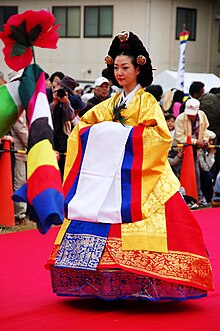Wonsam
| Wonsam | |
 Hwangwonsam (Yellow wonsam) | |
| Korean name | |
|---|---|
| Hangul | 원삼 |
| Hanja | |
| Revised Romanization | wonsam |
| McCune–Reischauer | wonsam |
The wonsam is a female ceremonial topcoat in hanbok. It originated from China,[1] and it was worn by queens, high-ranking court ladies, and royalty during the Joseon dynasty of Korea (1392–1910).[2] It is also called 'daeui' (
Origins and development
[edit]Origins
[edit]The wonsam originated from China and is believed to be one of the clothing of the Tang dynasty introduced in the Unified Three Kingdom periods of Korea.[1] Since then, it has become part of the Korean national customs.[1]
According to Hong Nayoung, the wonsam is also hypothesized to have originated from another garment called dansam (unlined jacket), which was used in early Joseon and originated from China.[5][6] The Chinese Ming dynasty bestowed the ceremonial attire and daily clothing to the Joseon queens from the reign of King Munjong to the reign of King Seonjo whenever a new king was enthroned; the bestowed clothing included o (
Development
[edit]Throughout the Joseon dynasty, the form and shape of the wonsam evolved with time. The formative characteristics of the wonsam can be divided into four stages:[7]
- 15th–16th century AD wonsam: the wonsam in this period included the a danryeong-shaped wonsam, a form of wonsam which was similar to the danryeong and included danryeong collars, side pleats (called Moo) with multiple inner folds, straight sleeves in the shape of cylinders and a belt which was tied with the wonsam.[7]
- Early 17th – Mid 17th century AD wonsam (which also be referred as the transitional wonsam): it was a complex combination of the danryeong and what is known as wonsam; during this period, many forms and shapes were developed in short period of time.[7] This transitional wonsam was a stepping-stone to the late development of the wonsam in the later years.[7]
- Mid 17th century AD wonsam – 19th century wonsam: The shape of the wonsam became more stable; during this period, the wonsam had collars which faced each other, and big and wide sleeves with stripes of multiple colours.[7] It also featured hansam (i.e. a curve-edge side seams) and side pleats (moo) without any multiple inner folds.[7] The clothing also changed from single-layered to double layeres, and new colours such as dark blue to green colour appeared.[7]
- Late 19th to 20th century AD wonsam: The characteristics and fabrics used in the wonsam became more standard, and there were now two types of wonsam: (1) the ceremonial robe used in court, and (2) the wonsam used by commoners as ceremonial robe on their wedding.[7]
Design and construction
[edit]The color and decorations of the garment around the chest, shoulders and back represent the wearer's rank.[2] For example, the colour yellow was used for the wonsam of empresses, red for queens, jajeok (
Varieties of silk were used as the fabric. Wonsam for winter were made with dan (緞), a thick silk with a glossy surface formed with a satin weave,[11] and wonsam for summer were made with sa (
Unlike the po, an indigenous Korean overcoat with narrow sleeves, the wonsam was based on women’s half-sleeve round collar robe that was worn in 15th century.[verification needed] After the Qing invasion of Joseon, its sleeves have gotten longer and wider.[verification needed] As an adaptation from the original model, the wonsam gradually evolved into a distinctive form characteristic of traditional Korean clothing.[8]
Modern use
[edit]Today the wonsam is worn primarily in representations of Joseon royal ceremonies and as a wedding garment, and in a much simplified version when performing traditional Korean dances.[13][14]
Gallery
[edit]-
Nokwonsam (green wonsam) for a princess[15]
-
Nokwonsam exhibited at Asian Art Museum of San Francisco
-
Dancers in wonsam performing a Korean dance, Taepyeongmu
See also
[edit]References
[edit]- ^ a b c d Nam, Min-yi (2000). "A Study on the Items and Shapes of Korean Shrouds" (PDF). The International Journal of Costume Culture. 3 (2): 100–123. Archived from the original on 2021-05-09.
- ^ a b c "Official/Court clothing". Life in Korea.
- ^ 원삼 (
圓 衫) (in Korean). Empas / Britannica. - ^ a b 원삼 (
圓 衫) (in Korean). Empas / EncyKorea. - ^ a b c Hong, Nayoung. "원삼 (
圓 衫 )". Encyclopedia of Korean Folk Culture (in Korean). Retrieved 2022-04-02. - ^ a b Hong, Nayoung. "원삼(
圓 衫)". 한국민속대백과사전 [Encyclopedia of Korean Folk culture] (in Korean). Retrieved 2022-04-02. - ^ a b c d e f g h Lim, Hyunjoo; Cho, Hyosook (2013). "A Study on the Periodic Characteristics of Wonsam in the Joseon Dynasty". Journal of the Korean Society of Costume. 63 (2): 29–44. doi:10.7233/jksc.2013.63.2.029. ISSN 1229-6880.
- ^ a b 원삼 (
圓 衫) (in Korean). Doosan Encyclopedia. - ^ Color and design. Marilyn Revell DeLong, Barbara Martinson. London: Berg Publishers. 2012. ISBN 978-1-84788-953-9. OCLC 853455231.
{{cite book}}: CS1 maint: others (link) - ^ Shim, Hwa-jin (2004). 우리옷 만들기 [Making our clothes] (in Korean). Seoul: Sungshin Women's University Press. p. 194.
- ^ 단 (緞) (in Korean). Empas / Britannica.
- ^ 사 (
紗 ) (in Korean). Empas / EncyKorea. - ^ Hanbok Korean Overseas Information Service
- ^ Dongnae Gomu(Dongnae Drum Dance) Busan Folklore Conservation Association
- ^ Traditional Korean Wedding Dress to be Exhibited at Smithsonian Museum

![Nokwonsam (green wonsam) for a princess[15]](https://upload.wikimedia.org/wikipedia/commons/thumb/b/ba/Korea-Hanbok-Queen-01.jpg/120px-Korea-Hanbok-Queen-01.jpg)

